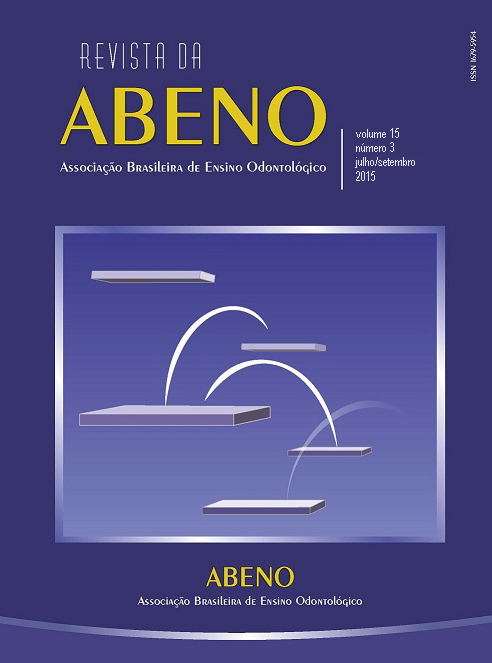Most effective learning experiences for dental students
DOI:
https://doi.org/10.30979/rev.abeno.v15i3.199Keywords:
Learning. Teaching. Dental Education.Abstract
The teacher-centered method is still widely used in most universities in Brazil. This method does not prioritize the active participation of the student in the knowledge construction process. The objective of this research was to identify the most significant learning experience according dental students. A quantitative study, with descriptive and analytical analysis using pre-tested questionnaire was conducted. Of the total students, 209 (76.3%) were female, with a mean age of 21.3±2.5 years. The results showed that the teaching strategy that most contributed to student learning activities were developed in practical classes, 186 (67.9%), contributing for 171 (92.3%) students, intensively for their training. The second most cited teaching strategy by dental students was to participate in extension projects (17 / 6.2%). There was a trend in preference for extracurricular activities among female dental students. There was no statistically significant difference between learning experience preference and age (p=0.211). Activities in practical lessons were the ones that most contributed to learning for dental students. It is expected that the results of this study, together with the National Curriculum Guidelines could contribute in the discussion about the need of improvement and innovation in dental education.Downloads
References
Demo, P. Política social do conhecimento. Amélia Hamze Colunista Brasil Escola Disponível em: http://educador.brasilesco la.com/trabalho-docente/o-que-e-aprendi zagem.htm
Lazzarin HC, Nakama L, Júnior LC. O papel do professor na percepção dos alunos de odontologia. Saúde e Sociedade 2007;16(1):90–101.
Araujo ME. Palavras e silêncios na educação superior em odontologia. Ciênc Saúde Coletiva 2006;11(1):179–82.
Guimarães FAF, Mello ALSF, Pires ROM. Formação Profissional em Odontologia: Revisão de Literatura. Rev Saúde Pública Santa Catarina 2015;7(3):75–87.
Garbin CAS, Saliba NA, Moimaz SAS, Santos KT, O papel das universidades na formação de profissionais na área de saúde. Rev ABENO. 2006;6(1):6-10.
Mitre SM, Siqueira-Batista R, Girardi-de-Mendonça JM, Morais-Pinto NM de, Meirelles C de AB, Pinto-Porto C, et al. Metodologias ativas de ensino-aprendizagem na formação profissional em saúde: debates atuais. Ciênc Saúde Coletiva 2008;13(2):2133–44.
Boruchovitch E, Santos AAA, Costa ER, Neves ERC, Cruvinel M, Primi R, et al. A construção de uma escala de estratégias de aprendizagem para alunos do ensino fundamental. Psicologia: Teoria e Pesquisa 2006;22(3):297-304.
Dembo MH. Applying educational psychology. 5th ed. New York: Longman; 1994.
Oliveira KL, Boruchovitch E, Santos AAA. Estratégias de aprendizagem e desempenho acadêmico: evidências de validade. Psicologia: Teoria e Pesquisa 2009;25(4):531-6.
Almeida LS. Facilitar a aprendizagem: ajudar os alunos a aprender e a pensar. Psicologia escolar e educacional. 2002;6(2):155–65.
Freire P. Educação e mudança. São Paulo: Paz e Terra; 1999.
Freire P. Pedagogia da autonomia: saberes necessários à prática educativa. 33ª ed. São Paulo: Paz e Terra; 2006.
Araújo RJG, Figueiredo LBA, Ribeiro RR. Conhecimento de estratégias pedagógicas no processo ensino–aprendizagem dos alunos do curso de Odontologia. Full Dent Sci 2014;5 (19):464–71.
Mendes RF, Moura MS, Prado Júnior RR, Moura LFAD, Lages GP, Gonçalves MPR. Contribuição do Estágio Supervisionado da UFPI para formação humanística, social e integrada. Rev ABENO 2006;6(1):61-5.
Fadel CB, Baldani MH. Percepções de formando do curso de odontologia sobre as diretrizes curriculares nacionais. Trab Educ Saúd 2013;11(2):339-354.
Klimenko O. La creatividad como un desafío para la educación del siglo XXI. Educación y Educadores. 2009;11(2):191-210.
Edwards PC. The future of dental education: toward disruptive innovation or incremental improvements? Oral Surg Oral Med Oral Pathol Oral Radiol 2015;119(3):257-9.
Hupp J. Innovation in dental education: empty buzzword or real movement? Oral Surg Oral Med Oral Pathol Oral Radiol Endod 2008;105(1):1-4.
Freeman S, Eddy SL, McDonough M, Smith MK, Okoroafor N, Jordt H, Wenderoth MP. Active learning increases student performance in science, engineering, and mathematics. Proc Natl Acad Sci USA 2014;111(23):8410-5.
Downloads
Published
How to Cite
Issue
Section
License
Autores que publicam nesta revista concordam com os seguintes termos:
a) Autores mantém os direitos autorais e concedem à revista o direito de primeira publicação, com o trabalho simultaneamente licenciado sob a Licença Creative Commons Attribution que permite o compartilhamento do trabalho com reconhecimento da autoria e publicação inicial nesta revista.
b) Autores têm autorização para assumir contratos adicionais separadamente, para distribuição não-exclusiva da versão do trabalho publicada nesta revista (ex.: publicar em repositório institucional ou como capítulo de livro), com reconhecimento de autoria e publicação inicial nesta revista.
c) Autores têm permissão e são estimulados a publicar e distribuir seu trabalho online (ex.: em repositórios institucionais ou na sua página pessoal) a qualquer ponto antes ou durante o processo editorial, já que isso pode gerar alterações produtivas, bem como aumentar o impacto e a citação do trabalho publicado (Veja O Efeito do Acesso Livre).






